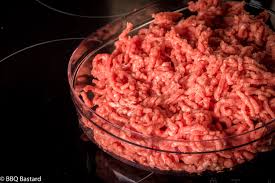
When it comes to minced meat, do I chuck or do I topside?
In previous posts I have written about the cooking of tough cuts versus cooking of tender cuts.
The general rule is that tough cuts, having a high level of connective tissue, are naturally flavourful and need long and slow cooking to achieve doneness.
However once minced the connective tissue has been broken down and you can now cook a tough cut using a quick cooking method such as pan frying.
Tough cuts are cheaper than their tender counterparts so it stands to reason that the most likely cuts a butcher would mince would be the tough ones. Of course, there are exceptions such as butchers who want to offer a particular up – market mince and proudly promote it as such. In this case they would use one of the tender cuts to mince.
I have seen the topside and the chuck (both tough cuts) as the most commonly used cuts to mince.
Both have their advantages:
Topside is quite lean and for this reason, once minced, would be suitable for bolognaise (or bolognaise related meals). The reason being is that there is not much fat or gelatin so it doesn’t release any excess fat residue into the bolognaise.
Chuck, on the other hand, is high in fat and gelatine so it really adds value because of the juiciness and flavour that it imparts. It is for this reason that this cut makes for delicious hamburgers.
Cooking with minced meat is great! You can create quick, affordable, delicious, and wholesome meals such as bolognaise sauce (for spaghetti, lasagne, or potato pie dishes to name a few). Minced meat is simple to use. You can make a large meal to feed a group of you and also, the meals can easily last several days so you can make the meal once and you don’t have to think about what’s for dinner for a few days.
Now that you have an idea of what mince you need for what type of meals, pick up some minced meat from your local butcher and get cooking!
For more on cooking red meat please visit www.yourmeatmate.com
